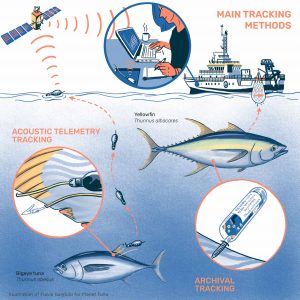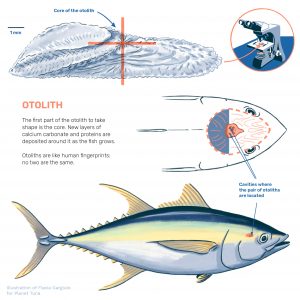What are the best sources of research on the migratory patterns of bigeye and yellowfin tuna? Is there a difference between the migratory patterns of these two species?
__________________________
Mayana, from Brazil, asked us: What are the best sources of research on the migratory patterns of bigeye and yellowfin tuna? Is there a difference between the migratory patterns of these two species?
Iraide Artetxe from AZTI and Hilario Murua from International Seafood Sustainability Foundation answered:
The most common method for researching the migration of tunas, including these two species, involves mark and recapture techniques with artificial tags, which can be classified into two main groups: conventional and electronic tags. Conventional tagging requires marking the fish with an identifier that makes it possible to estimate apparent movement patterns and distances travelled when the specimen is recaptured. Electronic tagging, also known as fish telemetry, does not necessarily require recapture. Besides, it provides more detailed information, such as daily fish position, as well as measurements of the environmental and physiological parameters experienced by the tagged fish. In the specific case of yellowfin and bigeye tunas, conventional and electronic tagging studies show that, broadly speaking, the horizontal migratory patterns of both species are quite similar: large scale movements occur between their spawning habitat (in tropical oceanic waters) and feeding grounds (in more southern and northern oceanic latitudes). These extensive migrations can cover hundreds or thousands of miles. However, there is a difference in the diel vertical migrations of these two species, as bigeye tuna can swim to deeper and colder waters than yellowfin tuna.
Going into further detail, individuals belonging to the same species can show divergent migrations throughout their lives, due to behavioral differences (e.g., “explorers” vs “residents”) among individuals and/or different sub-population dynamics. However, tracking these migratory patterns within the species distribution range is more challenging. Electronic tagging devices can provide geolocation estimates for a given fish, but data over its entire lifespan are not always easy to collect, either because the fish cannot retain the tag over time or because the batteries run out, among other reasons. Alternatively, we can analyze the chemical composition of fish tissues, such as otoliths (i.e. hard calcareous granules found in their inner ear) that can reflect the environment experienced by the fish. As the concentration of certain elements varies in a predictable manner across the ocean and between ocean regions, the element composition found in these fish tissues (e.g. otoliths) can be matched to specific oceanic locations and thus provide a natural geospatial tag. Although this approach shows the potential for deciphering migratory patterns of species with large ocean-basin scale migrations such as yellowfin and bigeye tuna, for the moment it is more of a goal than a reality.
Sources:
McKenzie, J., Parsons, B., Seitz, A., Kopf, R., Mesa, M. y Phelps, Q. (2012). Advances in fish tagging and marking technology. American Fisheries Society.

This content is part of the ocean education program, Centinelas, and deals on Sustainable Development Goal 14, Life Under Water.

With the collaboration:






